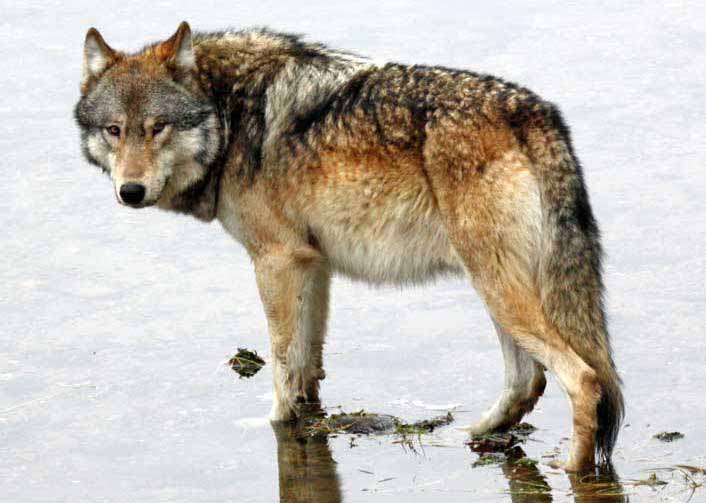Wyoming wildlife official says
wolves unlikely to thrive
outside state's northwestern corner
CODY, WYO. — After nearly two decades since their reintroduction in Yellowstone National Park, population trends show that gray wolves are unlikely to thrive in sections of Wyoming outside the northwestern corner of the state.
Many wolf supporters remain dissatisfied with Wyoming's so-called "dual status" management approach, which classifies wolves as trophy game in the area around Yellowstone and as predators elsewhere. But a state wildlife official said Thursday that policy changes won't have much effect on wolf numbers across most of the state.
Relatively poor habitat and higher rates of development make most of Wyoming a place where wolves have had—and will continue to experience—trouble establishing thriving packs, said Mark Bruscino, supervisor of the large carnivore section of the Wyoming Game and Fish Department.Bruscino spoke about the past and future of wolf management in Wyoming during a lecture at the Buffalo Bill Historical Center.
Bruscino said the state's first regulated wolf hunt, held this past winter, went "incredibly well."
Wyoming wolf hunts in areas around Yellowstone are highly regulated, and hunting of any kind is not allowed inside the park. But wolves across most of Wyoming are considered predators, and may be shot without a license.
The legal killing in December of a high-profile alpha female from Yellowstone's Lamar Canyon pack that wandered outside the park drew criticism from many wolf supporters. Several other wolves that frequent the park, including animals collared for research purposes, were also legally shot in state-managed hunts.
Out of a quota up to 52 wolves that could be killed during Wyoming's hunt, licensed hunters killed 42, and a few additional wolves were poached east and south of Yellowstone.
Bruscino said that wolves, like other wildlife, regularly move across the park's boundaries, and that "we need to be careful about assigning ownership" of wolves to a particular place.
"It isn't like there is a Yellowstone National Park subpopulation. It's all the same population of wolves right now," he said.
Wolves may disperse to find a mate or seek better habitat or sources of prey, and often cover vast distances, Bruscino said.He said Wyoming's wolf hunt did not disproportionately affect any single pack, and that "all the packs are pretty much in tact" heading into spring.
Pack sizes in hunt areas were reduced on average from seven to five wolves, he said.
Wolf numbers in Yellowstone have "flattened out" to approximately 100, he said, and that number is likely to remain in the same range in years to come.
Outside the park, Wyoming's northwestern region probably has a carrying capacity of between 200-250 wolves, Bruscino said, and a long-term average of about 200 wolves is likely to emerge across the region outside Yellowstone.
Regardless of where the numbers end up over the long term, it is likely to be too many for those who don't want wolves in Wyoming at all, and too few for those who would like to see wolves restored to their historic range across North America.
But wolves should be neither vilified nor placed on a pedestal, Bruscino said."They're just like any other critter out there, and we need to manage them like other wildlife," he said.
"Wolves are easy to manage. They're very resilient and there is a whole wide range of management options you can use on wolf populations, and the wolves do quite well," said Bruscino, who helped capture wolves in Alberta, Canada in 1995 that were later released in Yellowstone.
Bruscino, who plans to retire later this year, said it has been "the socio-political aspect of this thing that's been incredibly challenging and difficult."











2 comments:
Why do people who work for state fish and game departments or for federal wildlife agencies call it "wildlife management" when all that really means is wildlife kill quotas or how many they intend to kill for a given year? That is not management of wildlife. That is game farming with these agents and other supervisors playing the part of overseer. They all act like wolves and other predators are multiplying like mice and their numbers are so vast that killing them off by whatever means nessessary should be looked upon as them doing an outstanding job of "wildlife management". True wildlife managers would be more concerned about protecting and preserving wildlife be they predator or ungulate I would think.
Ionna..............appreciate your commentary over the past few days..........As George Wuerthner and many other like minded carnivore experts put it, state wildlife commissions are corrupted by the special interest folks, whether they be farming, ranching or hunting----these constituencies put big $$ behind Governors who are beholden to their interests regarding "managing" wildlife--state biologists go along for the ride employing aberrant wildlife maxims
Post a Comment